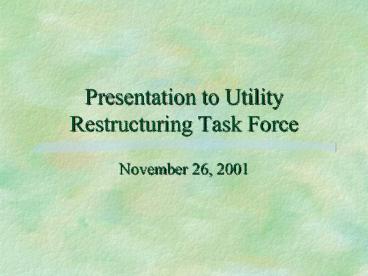Presentation to Utility Restructuring Task Force PowerPoint PPT Presentation
1 / 20
Title: Presentation to Utility Restructuring Task Force
1
Presentation to Utility Restructuring Task Force
- November 26, 2001
2
ComparisonHB 2759 Bill
compared to what DEQ already does.
HB 2759 DEQ
3
DEQ PermittingState Permit Program
- A state program operated under regulations
adopted by the State Air Pollution Control Board. - For emissions ? 250 tpy.
- ?100 tpy for certain source categories.
- Used statewide for sources less than federal
major in size (non PSD).
4
State Permit Program (contd)
- Requires a technology review for utilization of
proven controls. - Requires an air quality analysis to determine
impact of emissions on health based air quality
standards.
5
State Permit Program (contd)
- Source must be designed, built, and equipped to
operate without interferring with attainment or
maintenance of any air quality standard. - Conservative screening models are use i.e.
- (1) Worst case emissions
- (2) Worst case meteorology
6
State Permit Program (contd)
- Results from this model always over predict the
impact - If you pass this test, real world impacts will
always be less.
7
Prevention of Significant Deterioration (PSD)
Permit Program
- A national program established by the Clean Air
Act. - Used for major sources in attainment areas.
- Requires Best Available Control Technology
(BACT). - Requires two air quality impact analyses
- a) PSD increment consumption.
- b) Impact on air quality standards if
significant.
8
Modeling Analysis
- EPA established national significant impact
levels for source alone. - If insignificant, no further analysis is needed.
- If impact is significant, you model the impact on
the significant area for those sources within the
significance area plus sources located 50
kilometers beyond the significance area.
9
Modeling Analysis (contd)
- Significant level for NO2 -- (annual standard is
100 micrograms per cubic meter). - 1. Class II areas (most of Virginia)
- 1 micrograms per cubic meter.
- 2. Class I areas (Shenandoah
- National Park and James River
- Face Wilderness area 0.1
- micrograms per cubic meter.
10
Modeling Analysis (contd)
- Initial modeling is very conservative using
- a) Maximum predicted
- emissions.
- b) Worst case meteorology.
- Predicted impact will be greater than what really
happens. - Significant impact level (SIL) varies for Class
II and Class I areas. - Sources must pass both tests.
11
Modeling Analysis (contd)
- While cumulative impact is not defined anywhere,
the PSD analysis for criteria pollutants is, in
effect, a cumulative analysis.
12
Impact on Ozone
- No individual source model approved by EPA for
predicting ozone impact. - We do this periodically with multiple sources to
satisfy public concern. - It is expensive and time consuming.
- The procedure we use is as follows
- a) Photochemical model -- to predict ozone
- impact.
13
Impact on Ozone (contd)
- b) Emissions Model -- to include all sources
- within the domain.
- c) Meteorological model for met data.
- d) Ozone episode July 4 - 8, 1996.
- e) Domain modeled contains 5,175 grid
cells, - each 12 kilometers by12 kilometers.
14
Impact on Ozone (contd)
- Latest run used these eight plants
- Dominion Virginia Power Remington 249T.
- Dominion Virginia Power Ladysmith 249T.
- ODEC Louisa
244.7T. - Tenaska - Fluvanna County
577T. - Com. Chesapeake Power Station
119T. - White Oak - Pittsylvania County
602T. - Mirant - Pittsylvania County
400T. - Competitive Power Vent, Fluvanna
321T. Total Emissions -- 2,761.7 Tons
15
Maximum Ground Level Impact
- 2.3 PPB in 4 grid cells.
- 1.0 PPB or above in 30 grid cells.
- Negligible in all other cells.
- 1 PPB impact in Northern Virginia.
- Negligible impact in Richmond and Hampton Roads
maintenance areas. - Well below what is considered significant for
this type of model i.e. 10 ppb
16
Public Information
- DEQ web site contains a wealth of information
about proposed sources including - 1. General Description
- 2. Plant Name
- 3. Location
- 4. Application Status
- 5. Permit Type
- 6. Facility Type
- 7. Agency Contact
17
Public Information (contd)
- Most such facilities require a public briefing
about the facility, plus a public hearing on the
proposed permit. - Info on AQ impacts is provided to the public
prior to and during these hearings.
18
Cumulative Impact Analysis for Ozone
- It is expensive to do.
- To set up to do this with an outside firm would
cost between 100,000 and 500,000. - Putting data in takes five working days.
- If we used a different ozone episode, it would
take 3 months.
19
Cumulative Impact (contd)
- Modeling and post processing takes 10-15 work
days. - Cost using existing episode is about 10,000.
- Much more than that for a new episode.
- Limitations
- 1) Model not sensitive enough for evaluating a
- single source.
- 2) Typically we do model for groups of 8 - 10
- plants.
20
In Summary
- DEQ will not issue a permit if a facilitys
emissions would adversely affect health based air
quality standards adopted by EPA (NAAQS).

